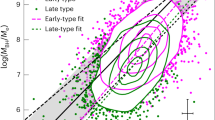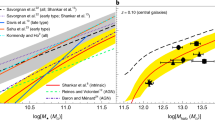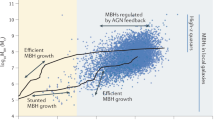Abstract
Supermassive black holes are found at the centres of massive galaxies. During the growth of these black holes they light up to become visible as active galactic nuclei (AGNs) and release extraordinary amounts of energy across the electromagnetic spectrum. This energy is widely believed to regulate the rate of star formation in the black holes’ host galaxies via so-called AGN feedback. However, the details of how and when this occurs remain uncertain from both an observational and theoretical perspective. I review some of the theoretical motivation and observational results and discuss possible observational signatures of the impact of supermassive black hole growth on star formation.
This is a preview of subscription content, access via your institution
Access options
Access Nature and 54 other Nature Portfolio journals
Get Nature+, our best-value online-access subscription
$29.99 / 30 days
cancel any time
Subscribe to this journal
Receive 12 digital issues and online access to articles
$119.00 per year
only $9.92 per issue
Buy this article
- Purchase on Springer Link
- Instant access to full article PDF
Prices may be subject to local taxes which are calculated during checkout




Similar content being viewed by others
References
Soltan, A. Masses of quasars. Mon. Not. R. Astron. Soc. 200, 115–122 (1982).
Marconi, A. et al. Local supermassive black holes, relics of active galactic nuclei and the X-ray background. Mon. Not. R. Astron. Soc. 351, 169–185 (2004).
Kormendy, J. & Ho, L. C. Coevolution (or not) of supermassive black holes and host galaxies. Annu. Rev. Astron. Astrophys. 51, 511–653 (2013).
Valageas, P. & Silk, J. The entropy history of the Universe. Astron. Astrophys. 350, 725–742 (1999).
Croton, D. J. et al. The many lives of active galactic nuclei: cooling flows, black holes and the luminosities and colours of galaxies. Mon. Not. R. Astron. Soc. 365, 11–28 (2006).
Somerville, R. S., Hopkins, P. F., Cox, T. J., Robertson, B. E. & Hernquist, L. A semi-analytic model for the co-evolution of galaxies, black holes and active galactic nuclei. Mon. Not. R. Astron. Soc. 391, 481–506 (2008).
Ciotti, L., Ostriker, J. P. & Proga, D. Feedback from central black holes in elliptical galaxies. III. Models with both radiative and mechanical feedback. Astrophys. J. 717, 708–723 (2010).
Gaspari, M., Melioli, C., Brighenti, F. & D’Ercole, A. The dance of heating and cooling in galaxy clusters: three-dimensional simulations of self-regulated active galactic nuclei outflows. Mon. Not. R. Astron. Soc. 411, 349–372 (2011).
Dubois, Y., Gavazzi, R., Peirani, S. & Silk, J. AGN-driven quenching of star formation: morphological and dynamical implications for early-type galaxies. Mon. Not. R. Astron. Soc. 433, 3297–3313 (2013).
Vogelsberger, M. et al. Introducing the Illustris Project: simulating the coevolution of dark and visible matter in the Universe. Mon. Not. R. Astron. Soc. 444, 1518–1547 (2014).
Crain, R. A. et al. The EAGLE simulations of galaxy formation: calibration of subgrid physics and model variations. Mon. Not. R. Astron. Soc. 450, 1937–1961 (2015).
King, A. & Pounds, K. Powerful outflows and feedback from active galactic nuclei. Annu. Rev. Astron. Astrophys. 53, 115–154 (2015).
Markevitch, M. The L X–T relation and temperature function for nearby clusters revisited. Astrophys. J. 504, 27–34 (1998).
Fabian, A. C. Cooling flows in clusters of galaxies. Annu. Rev. Astron. Astrophys. 32, 277–318 (1994).
Behroozi, P. S., Wechsler, R. H. & Conroy, C. The average star formation histories of galaxies in dark matter halos from z = 0–8 Astrophys. J. 770, 57 (2013).
Strateva, I. et al. Color separation of galaxy types in the Sloan Digital Sky Survey imaging data. Astron. J. 122, 1861–1874 (2001).
Shapiro, S. L. & Teukolsky, S. A. Black holes, white dwarfs, and neutron stars: The physics of compact objects (John Wiley & Sons, 1983).
Cattaneo, A. et al. The role of black holes in galaxy formation and evolution. Nature 460, 213–219 (2009).
Weinberger, R. et al. Simulating galaxy formation with black hole driven thermal and kinetic feedback. Mon. Not. R. Astron. Soc. 465, 3291–3308 (2017).
Silk, J. & Rees, M. J. Quasars and galaxy formation. Astron. Astrophys. 331 L1–L4 (1998).
King, A. Black holes, galaxy formation, and the MBH–σ relation. Astrophys. J. Lett. 596 L27–L29 (2003).
Springel, V., Di Matteo, T. & Hernquist, L. Modelling feedback from stars and black holes in galaxy mergers. Mon. Not. R. Astron. Soc. 361, 776–794 (2005).
Hopkins, P. F. et al. A unified, merger-driven model of the origin of starbursts, quasars, the cosmic X-ray background, supermassive black holes, and galaxy spheroids. Astrophys. J. Suppl. 163, 1–49 (2006).
Choi, E., Ostriker, J. P., Naab, T., Oser, L. & Moster, B. P. The impact of mechanical AGN feedback on the formation of massive early-type galaxies. Mon. Not. R. Astron. Soc. 449, 4105–4116 (2015).
Best, P. N. & Heckman, T. M. On the fundamental dichotomy in the local radio-AGN population: accretion, evolution and host galaxy properties. Mon. Not. R. Astron. Soc. 421, 1569–1582 (2012).
Aird, J. et al. PRIMUS: The dependence of AGN accretion on host stellar mass and color. Astrophys. J. 746, 90 (2012).
Heckman, T. M. & Best, P. N. The coevolution of galaxies and supermassive black holes: insights from surveys of the contemporary Universe. Annu. Rev. Astron. Astrophys. 52, 589–660 (2014).
Hickox, R. C. et al. Host galaxies, clustering, Eddington ratios, and evolution of radio, X-Ray, and infrared-selected AGNs. Astrophys. J. 696, 891–919 (2009).
Hernán-Caballero, A. et al. Higher prevalence of X-ray selected AGN in intermediate-age galaxies up to z ∼ 1. Mon. Not. R. Astron. Soc. 443, 3538–3549 (2014).
Tasse, C., Best, P. N., Röttgering, H. & Le Borgne, D. Radio-loud AGN in the XMM-LSS field. II. A dichotomy in environment and accretion mode? Astron. Astrophys. 490, 893–904 (2008).
Best, P. N., Ker, L. M., Simpson, C., Rigby, E. E. & Sabater, J. The cosmic evolution of radio-AGN feedback to z = 1. Mon. Not. R. Astron. Soc. 445, 955–969 (2014).
Padovani, P. et al. Radio-faint AGN: a tale of two populations. Mon. Not. R. Astron. Soc. 452, 1263–1279 (2015).
McNamara, B. R. & Nulsen, P. E. J. Mechanical feedback from active galactic nuclei in galaxies, groups and clusters. New J. Phys. 14, 055023 (2012).
Fabian, A. C. Observational Evidence of Active Galactic Nuclei Feedback. Annu. Rev. Astron. Astrophys. 50, 455–489 (2012).
Donoso, E., Li, C., Kauffmann, G., Best, P. N. & Heckman, T. M. Clustering of radio galaxies and quasars. Mon. Not. R. Astron. Soc. 407, 1078–1089 (2010).
McCarthy, I. G. et al. Gas expulsion by quasar-driven winds as a solution to the overcooling problem in galaxy groups and clusters. Mon. Not. R. Astron. Soc. 412, 1965–1984 (2011).
Heckman, T. M. et al. Present-day growth of black holes and bulges: the Sloan Digital Sky Survey perspective. Astrophys. J. 613, 109–118 (2004).
Thomas, D., Maraston, C., Bender, R. & Mendes de Oliveira, C. The epochs of early-yype galaxy formation as a function of environment. Astrophys. J. 621, 673–694 (2005).
Schawinski, K. et al. The green valley is a red herring: galaxy zoo reveals two evolutionary pathways towards quenching of star formation in early- and late-type galaxies. Mon. Not. R. Astron. Soc. 440, 889–907 (2014).
Veilleux, S., Cecil, G. & Bland-Hawthorn, J. Galactic winds. Annu. Rev. Astron. Astrophys. 43, 769–826 (2005).
Alexander, D. M. & Hickox, R. C. What drives the growth of black holes? New Astron. Rev. 56, 93–121 (2012).
Ganguly, R. & Brotherton, M. S. On the fraction of quasars with outflows. Astrophys. J. 672, 102–107 (2008).
Tombesi, F. et al. Evidence for ultra-fast outflows in radio-quiet AGNs. I. Detection and statistical incidence of Fe K-shell absorption lines. Astron. Astrophys. 521 A57 (2010).
Rupke, D. S., Veilleux, S. & Sanders, D. B. Outflows in active galactic nucleus/starburst-composite ultraluminous infrared galaxies. Astrophys. J. 632, 751–780 (2005).
Dunn, J. P. et al. The quasar outflow contribution to AGN Feedback: VLT measurements of SDSS J0318–0600. Astrophys. J. 709, 611–631 (2010).
Sturm, E. et al. Massive molecular outflows and negative feedback in ULIRGs observed by Herschel-PACS. Astrophys. J. Lett. 733 L16 (2011).
Mullaney, J. R. et al. Narrow-line region gas kinematics of 24,264 optically selected AGN: the radio connection. Mon. Not. R. Astron. Soc. 433, 622–638 (2013).
Maiolino, R. et al. Evidence of strong quasar feedback in the early Universe. Mon. Not. R. Astron. Soc. 425 L66–L70 (2012).
Cicone, C. et al. Massive molecular outflows and evidence for AGN feedback from CO observations. Astron. Astrophys. 562 A21 (2014).
Harrison, C. M., Alexander, D. M., Mullaney, J. R. & Swinbank, A. M. Kiloparsec-scale outflows are prevalent among luminous AGN: outflows and feedback in the context of the overall AGN population. Mon. Not. R. Astron. Soc. 441, 3306–3347 (2014).
Nesvadba, N., De Breuck, C., Lehnert, M. D., Best, P. N. & Collet, C. The SINFONI survey of powerful radio galaxies at z ∼ 2: Jet-driven AGN feedback during the Quasar Era. Astron. Astrophys. 599, A123 (2017).
Tombesi, F. et al. Wind from the black-hole accretion disk driving a molecular outflow in an active galaxy. Nature 519, 436–438 (2015).
Feruglio, C. et al. The multi-phase winds of Markarian 231: from the hot, nuclear, ultra-fast wind to the galaxy-scale, molecular outflow. Astron. Astrophys. 583 A99 (2015).
Liu, G., Zakamska, N. L., Greene, J. E., Nesvadba, N. P. H. & Liu, X. Observations of feedback from radio-quiet quasars – II. Kinematics of ionized gas nebulae. Mon. Not. R. Astron. Soc. 436, 2576–2597 (2013).
Husemann, B. et al. Large-scale outflows in luminous QSOs revisited. The impact of beam smearing on AGN feedback efficiencies. Astron. Astrophys. 594 A44 (2016).
Rupke, D. S. N. & Veilleux, S. The multiphase structure and power sources of galactic winds in major mergers. Astrophys. J. 768, 75 (2013).
González-Alfonso, E. et al. Molecular outflows in local ULIRGs: Energetics from multitransition OH analysis. Astrophys. J. 836, 11 (2017).
Cano-Daz, M. et al. Observational evidence of quasar feedback quenching star formation at high redshift. Astron. Astrophys. 537 L8 (2012).
Carniani, S. et al. Fast outflows and star formation quenching in quasar host galaxies. Astron. Astrophys. 591 A28 (2016).
Gabor, J. M. & Bournaud, F. Active galactic nuclei-driven outflows without immediate quenching in simulations of high-redshift disc galaxies. Mon. Not. R. Astron. Soc. 441, 1615–1627 (2014).
Wylezalek, D., Zakamska, N. L., Liu, G. & Obied, G. Towards a comprehensive picture of powerful quasars, their host galaxies and quasar winds at z ∼ 0.5. Mon. Not. R. Astron. Soc. 457, 745–763 (2016).
Elbaz, D., Jahnke, K., Pantin, E., Le Borgne, D. & Letawe, G. Quasar induced galaxy formation: a new paradigm? Astron. Astrophys. 507, 1359–1374 (2009).
Cresci, G. et al. Blowin’ in the wind: both “negative” and “positive” feedback in an obscured high-z quasar. Astrophys. J. 799, 82 (2015).
Ho, L. C. [O ii] emission in quasar host galaxies: evidence for a suppressed star formation efficiency. Astrophys. J. 629, 680–685 (2005).
Guillard, P. et al. Exceptional AGN-driven turbulence inhibits star formation in the 3C 326N radio galaxy. Astron. Astrophys. 574 A32 (2015).
French, K. D. et al. Discovery of large molecular gas reservoirs in post-starburst galaxies. Astrophys. J. 801, 1 (2015).
Alatalo, K. et al. Suppression of star formation in NGC 1266. Astrophys. J. 798, 31 (2015).
Hardcastle, M. J. et al. Herschel-ATLAS/GAMA: a difference between star formation rates in strong-line and weak-line radio galaxies. Mon. Not. R. Astron. Soc. 429, 2407–2424 (2013).
Ellison, S. L., Teimoorinia, H., Rosario, D. J. & Mendel, J. T. The star formation rates of active galactic nuclei host galaxies. Mon. Not. R. Astron. Soc. 458 L34–L38 (2016).
Leslie, S. K., Kewley, L. J., Sanders, D. B. & Lee, N. Quenching star formation: insights from the local main sequence. Mon. Not. R. Astron. Soc. 455 L82–L86 (2016).
Mainieri, V. et al. Black hole accretion and host galaxies of obscured quasars in XMM-COSMOS. Astron. Astrophys. 535 A80 (2011).
Lutz, D. et al. The LABOCA survey of the extended Chandra Deep Field South: Two modes of star formation in active galactic nucleus hosts? Astrophys. J. 712, 1287–1301 (2010).
Page, M. J. et al. The suppression of star formation by powerful active galactic nuclei. Nature 485, 213–216 (2012).
Zinn, P.-C., Middelberg, E., Norris, R. P. & Dettmar, R.-J. Active galactic nucleus feedback works both ways. Astrophys. J. 774 66 (2013).
Karouzos, M. et al. A tale of two feedbacks: star formation in the host galaxies of radio AGNs. Astrophys. J. 784, 137 (2014).
Rosario, D. J. et al. The mean star-forming properties of QSO host galaxies. Astron. Astrophys. 560 A72 (2013).
Azadi, M. et al. PRIMUS: the relationship between star formation and AGN accretion. Astrophys. J. 806, 187 (2015).
Stanley, F. et al. A remarkably flat relationship between the average star formation rate and AGN luminosity for distant X-ray AGN. Mon. Not. R. Astron. Soc. 453, 591–604 (2015).
Shimizu, T. T. et al. Herschel far-infrared photometry of the Swift Burst Alert Telescope active galactic nuclei sample of the local Universe – III. Global star-forming properties and the lack of a connection to nuclear activity. Mon. Not. R. Astron. Soc. 466, 3161–3183 (2017).
Schaye, J. et al. The EAGLE project: simulating the evolution and assembly of galaxies and their environments. Mon. Not. R. Astron. Soc. 446, 521–554 (2015).
McAlpine, S. et al. The link between galaxy and black hole growth in the EAGLE simulation. Mon. Not. R. Astron. Soc. 468, 3395–3407 (2017).
Symeonidis, M. et al. AGN in dusty hosts: implications for galaxy evolution. Mon. Not. R. Astron. Soc. 433, 1015–1022 (2013).
Mullaney, J. R. et al. ALMA and Herschel reveal that X-ray-selected AGN and main-sequence galaxies have different star formation rate distributions. Mon. Not. R. Astron. Soc. 453 L83–L87 (2015).
Smethurst, R. J. et al. Galaxy zoo: evidence for rapid, recent quenching within a population of AGN host galaxies. Mon. Not. R. Astron. Soc. 463, 2986–2996 (2016).
Dugan, Z., Bryan, S., Gaibler, V., Silk, J. & Haas, M. Stellar signatures of AGN-jet-triggered star formation. Astrophys. J. 796, 113 (2014).
Peng, Y.-j. et al. Mass and environment as drivers of galaxy evolution in SDSS and zCOSMOS and the origin of the Schechter function. Astrophys. J. 721, 193–221 (2010).
Brinchmann, J. et al. The physical properties of star-forming galaxies in the low-redshift Universe. Mon. Not. R. Astron. Soc. 351, 1151–1179 (2004).
Whitaker, K. E. et al. Constraining the low-mass slope of the star formation sequence at 0.5 < z < 2.5. Astrophys. J. 795, 104 (2014).
Schreiber, C. et al. The Herschel view of the dominant mode of galaxy growth from z = 4 to the present day. Astron. Astrophys. 575 A74 (2015).
Cowley, M. J. et al. ZFOURGE catalogue of AGN candidates: an enhancement of 160-μm-derived star formation rates in active galaxies to z = 3.2. Mon. Not. R. Astron. Soc. 457, 629–641 (2016).
McAlpine, S. et al. The EAGLE simulations of galaxy formation: Public release of halo and galaxy catalogues. Astron. Comput. 15, 72–89 (2016).
Beckmann, R. S. et al. Cosmic evolution of stellar quenching by AGN feedback: clues from the Horizon-AGN simulation. Preprint at https://arxiv.org/abs/1701.07838 (2017).
Thacker, R. J., MacMackin, C., Wurster, J. & Hobbs, A. AGN feedback models: correlations with star formation and observational implications of time evolution. Mon. Not. R. Astron. Soc. 443, 1125–1141 (2014).
Bongiorno, A. et al. AGN host galaxy mass function in COSMOS. Is AGN feedback responsible for the mass-quenching of galaxies? Astron. Astrophys. 588 A78 (2016).
Bluck, A. F. L. et al. The impact of galactic properties and environment on the quenching of central and satellite galaxies: a comparison between SDSS, Illustris and L-Galaxies. Mon. Not. R. Astron. Soc. 462, 2559–2586 (2016).
Terrazas, B. A. et al. Quiescence correlates strongly with directly measured black hole mass in central galaxies. Astrophys. J. Lett. 830 L12 (2016).
Hickox, R. C. et al. Black hole variability and the star formation-active galactic nucleus connection: Do all star-forming galaxies host an active galactic nucleus? Astrophys. J. 782, 9 (2014).
Novak, G. S., Ostriker, J. P. & Ciotti, L. Feedback from central black holes in elliptical galaxies: Two-dimensional models compared to one-dimensional models. Astrophys. J. 737, 26 (2011).
Zubovas, K., Nayakshin, S., King, A. & Wilkinson, M. AGN outflows trigger starbursts in gas-rich galaxies. Mon. Not. R. Astron. Soc. 433, 3079–3090 (2013).
Moster, B. P., Naab, T. & White, S. D. M. Galactic star formation and accretion histories from matching galaxies to dark matter haloes. Mon. Not. R. Astron. Soc. 428, 3121–3138 (2013).
Acknowledgements
I acknowledge the Science and Technology Facilities Council through grant code ST/L00075X/1. Thanks go to D. Alexander, D. Rosario, S. McAlpine and J. Mullaney for stimulating discussion. Thanks also go to the EAGLE consortium for making the data from their simulations publicly available.
Author information
Authors and Affiliations
Corresponding author
Ethics declarations
Competing interests
The author declares no competing financial interests.
Rights and permissions
About this article
Cite this article
Harrison, C. Impact of supermassive black hole growth on star formation. Nat Astron 1, 0165 (2017). https://doi.org/10.1038/s41550-017-0165
Received:
Accepted:
Published:
DOI: https://doi.org/10.1038/s41550-017-0165
This article is cited by
-
Science with a Small Two-Band UV-Photometry Mission III: Active Galactic Nuclei and Nuclear Transients
Space Science Reviews (2024)
-
Forming intracluster gas in a galaxy protocluster at a redshift of 2.16
Nature (2023)
-
The nature of compact radio sources: the case of FR 0 radio galaxies
The Astronomy and Astrophysics Review (2023)
-
Black-hole activity feedback across vast scales
Nature Astronomy (2022)
-
Frontiers in accretion physics at high X-ray spectral resolution
Nature Astronomy (2022)



